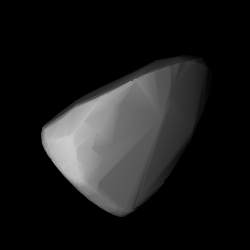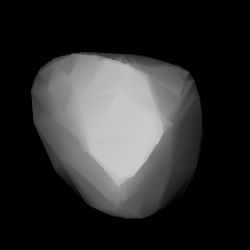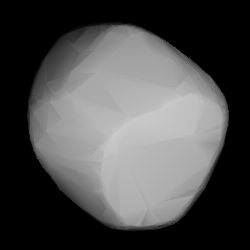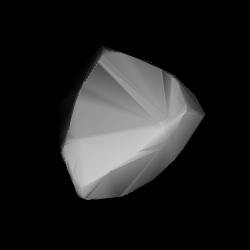
Stephania is a dark background asteroid from the inner regions of the asteroid belt, approximately 32 km (20 mi) in diameter. It was discovered on 19 May 1881, by Austrian astronomer Johann Palisa at the Vienna Observatory. The C-type asteroid has a rotation period of 18.2 hours. It was named after Princess Stéphanie of Belgium.

1554 Yugoslavia, provisional designation 1940 RE, is a stony Eunomian asteroid from the middle region of the asteroid belt, approximately 16 kilometres (9.9 mi) in diameter. It was discovered by Serbian astronomer Milorad Protić at Belgrade Astronomical Observatory, Serbia, on 6 September 1940. It was named for the former country of Yugoslavia.

1165 Imprinetta, provisional designation 1930 HM, is a carbonaceous Meliboean asteroid from the outer regions of the asteroid belt, approximately 49 kilometers (30 mi) in diameter. It was discovered on 24 April 1930 by Dutch astronomer Hendrik van Gent at the Union Observatory in Johannesburg, South Africa. The asteroid was named after Imprinetta Gent, wife of the discoverer.
1213 Algeria, provisional designation 1931 XD, is a carbonaceous asteroid from the outer region of the asteroid belt, approximately 32 kilometers in diameter. Discovered by Guy Reiss at Algiers Observatory in 1931, it was named after the North African country of Algeria.
11277 Ballard, provisional designation 1988 TW2, is a Phocaea asteroid from the inner regions of the asteroid belt, approximately 6.3 kilometers (3.9 miles) in diameter. It was discovered on 8 October 1988, by American astronomer couple Carolyn and Eugene Shoemaker at the Palomar Observatory in California. The assumed S-type asteroid has a rotation period of at least 10 hours. It was named for American marine scientist Robert Ballard.
2038 Bistro, provisional designation 1973 WF, is a stony asteroid from the inner regions of the asteroid belt, approximately 12 kilometers in diameter. The asteroid was discovered on 24 November 1973, by Swiss astronomer Paul Wild at the Zimmerwald Observatory near Bern, Switzerland. It was named for the Bistro restaurant.
1295 Deflotte, provisional designation 1933 WD, is a carbonaceous asteroid from the outer regions of the asteroid belt, approximately 48 kilometers in diameter. It was discovered on 25 November 1933, by French astronomer Louis Boyer at the Algiers Observatory in Algeria, North Africa. The asteroid was named after the discoverer's nephew.

1244 Deira is a dark background asteroid and slow rotator from the inner region of the asteroid belt. The X-type asteroid has an exceptionally long rotation period of 210.6 hours and measures approximately 31 kilometers in diameter. It was discovered on 25 May 1932, by English-born South African astronomer Cyril Jackson at the Union Observatory in Johannesburg, who named it after Deira, an old kingdom near his birthplace, the market town of Ossett, located in West Yorkshire, England.

1576 Fabiola, provisional designation 1948 SA, is a Themistian asteroid from the outer regions of the asteroid belt, approximately 27 kilometers in diameter. It was discovered on 30 September 1948, by Belgian astronomer Sylvain Arend at the Royal Observatory of Belgium in Uccle. The asteroid was named after Queen Fabiola of Belgium.
9298 Geake, provisional designation 1985 JM, is a Mitidika asteroid from the central regions of the asteroid belt, approximately 12 kilometers in diameter. It was discovered on 15 May 1985, by American astronomer Edward Bowell at Lowell Observatory's Anderson Mesa Station near Flagstaff, Arizona, United States. The asteroid was named for British astronomer John E. Geake.
1460 Haltia, provisional designation 1937 WC, is a stony background asteroid from the central regions of the asteroid belt, approximately 8 kilometers in diameter. It was discovered on 24 November 1937, by Finnish astronomer Yrjö Väisälä at the Iso-Heikkilä Observatory in Turku, Finland. The asteroid was named after Halti (Haltia), Finland's highest peak on the border to Norway.

1836 Komarov is a carbonaceous Dorian asteroid from the central region of the asteroid belt, approximately 22 kilometers in diameter. It was discovered on 26 July 1971 by Russian astronomer Nikolai Chernykh at Crimean Astrophysical Observatory in Nauchnij on the Crimean peninsula. It was named after Soviet cosmonaut Vladimir Komarov.
1261 Legia, provisional designation 1933 FB, is a dark Themistian asteroid from the outer regions of the asteroid belt, approximately 32 kilometers in diameter. It was discovered on 23 March 1933, by astronomer Eugène Delporte at the Royal Observatory of Belgium in Uccle. The asteroid was named for the Belgian city of Liège (Luke).
1303 Luthera, provisional designation 1928 FP, is a dark asteroid and the parent body of the Luthera family, located in the outermost regions of the asteroid belt. It measures approximately 90 kilometers in diameter. The asteroid was discovered on 16 March 1928, by astronomer Friedrich Schwassmann at the Bergedorf Observatory in Hamburg, Germany, and later named after German astronomer Robert Luther.
1646 Rosseland, provisional designation 1939 BG, is a stony asteroid from the inner regions of the asteroid belt, approximately 12 kilometers in diameter. It was discovered on 19 January 1939, by Finnish astronomer Yrjö Väisälä at Turku Observatory in Southwest Finland. It was later named after Norwegian astrophysicist Svein Rosseland.
1258 Sicilia, provisional designation 1932 PG, is a dark background asteroid from the outer regions of the asteroid belt, approximately 44 kilometers in diameter. It was discovered on 8 August 1932, by astronomer Karl Reinmuth at the Heidelberg-Königstuhl State Observatory in southwest Germany. The asteroid was named after the Italian island of Sicily.
2443 Tomeileen, provisional designation A906 BJ, is a stony Eoan asteroid from the outer regions of the asteroid belt, approximately 32 kilometers in diameter. It was discovered on 24 January 1906, by German astronomer Max Wolf at the Heidelberg-Königstuhl State Observatory in Heidelberg, Germany. The S-type asteroid was named after the parents of British astronomer Brian G. Marsden. It has a rotation period of 3.97 hours.
1447 Utra, provisional designation 1938 BB, is a stony asteroid, slow rotator and suspected tumbler from the central region of the asteroid belt, approximately 12 kilometers in diameter. It was discovered on 26 January 1938, by Finnish astronomer Yrjö Väisälä at Turku Observatory in Southwest Finland. The asteroid was named for the Finnish town of Utra.
1688 Wilkens, provisional designation 1951 EQ1, is a Mitidika asteroid from the central region of the asteroid belt, approximately 16 kilometers in diameter. It was discovered on 3 March 1951, by Argentine astronomer Miguel Itzigsohn at La Plata Observatory in the Province of Buenos Aires, Argentina, and named after astronomer Alexander Wilkens.
5176 Yoichi, provisional designation 1989 AU, is a background asteroid from the central regions of the asteroid belt, approximately 17 kilometers in diameter. It was discovered on 4 January 1989, by Japanese astronomers Seiji Ueda and Hiroshi Kaneda at the Kushiro Observatory on Hokkaido, Japan. The likely elongated asteroid has a brightness variation of 0.45 magnitude, and occulted a star in the constellation Cetus in November 2014. It was named for the Japanese town of Yoichi.






